Peanut butter may be a well-known treat for mutts, and numerous owners adore seeing their textured companions appreciate this nutty nibble.
But can mutts eat crunchy peanut butter, or is it way better to stick to the smooth assortment?
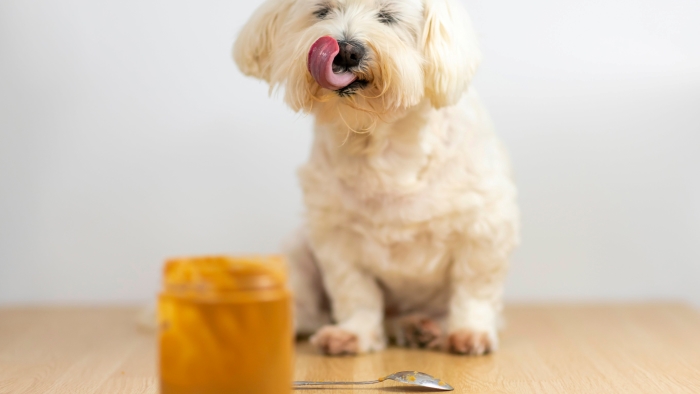
In this article, we’ll explore such facts like, Peanute butter basic, difference, benefits and dangers of giving your pooch crunchy Peanut butter and how to select the most excellent Peanut butter for your pup.
Contents
The Peanut Butter Basics
Before diving into the crunchy vs. creamy debate, let’s establish some basics about peanut butter and dogs. Peanut butter is a great source of protein, healthy fats, and vitamins B and E.
It can provide a quick energy boost and even some added nutrients for your furry companion. However, moderation is key, as peanut butter is also calorie–dense and can contribute to weight gain if over consumed.
Creamy vs. Crunchy Peanut Butter: Is There a Difference?
The fundamental distinction between creamy and crunchy peanut butter is texture. Creamy peanut butter is smooth and spreadable, but crunchy peanut butter contains tiny chunks of peanuts for a delightful crunch.
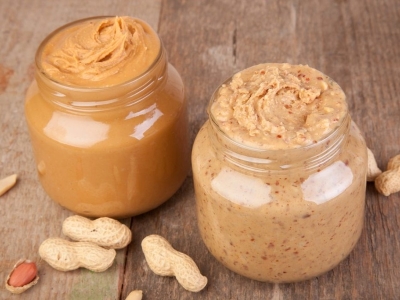
Both varieties are nutritionally equivalent, with similar levels of protein, fat, and other nutrients. However, some pet owners may be concerned by the gritty texture.
Benefits of Peanut Butter for Dogs
Peanut butter can be a tasty and nutritious treat for dogs when given in moderation and under the right circumstances. Here are some potential benefits of feeding peanut butter to dogs
Protein Source
Peanut butter contains protein, which is essential for muscle development, repair, and overall health[1] in dogs.
Healthy Fats
Peanut butter is a source of healthy fats, such as monounsaturated and polyunsaturated fats, which can contribute to a shiny coat and healthy skin.
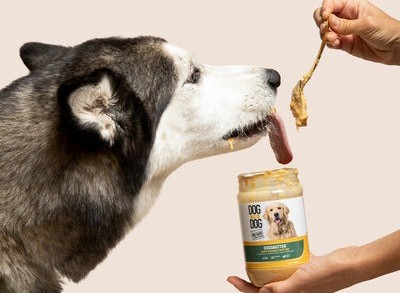
Vitamins and Minerals
Peanut butter includes vitamins and minerals such as vitamin E, vitamin B6, niacin, and magnesium, which can benefit a dog’s general health.
Energy Boost
Peanut butter is calorie–dense and can provide a quick energy boost, making it suitable for active dogs or as a reward during training sessions.
Mental Stimulation
Peanut butter can be used to stimulate dogs mentally, such as by stuffing it into puzzle toys or using it as a treat during training exercises, which can help keep their minds engaged.
Hide Medications
Peanut butter can be used to conceal drugs that dogs may otherwise refuse to take.
Bonding and Positive Association
Feeding peanut butter as an occasional treat can help strengthen the bond between you and your dog, creating positive associations with treats and interactions.
Risks of Peanut Butter for Dogs
While peanut butter can offer certain benefits to dogs, there are also potential risks and concerns associated with feeding it to them.
It’s important to be aware of these risks and take appropriate precautions:
Allergies
Some dogs can be allergic to peanuts or develop sensitivities to them. Signs of an allergic reaction may include itching[2], redness[3], swelling[4], digestive upset[5] (vomiting or diarrhea), and even difficulty breathing[6] in severe cases.
If you suspect your dog is allergic to peanuts or peanut butter, consult your veterinarian.
High Caloric Content
Peanut butter is calorie–dense, and excessive consumption can contribute to weight gain, especially in dogs that are less active or prone to obesity. Portion control is crucial to avoid overfeeding.
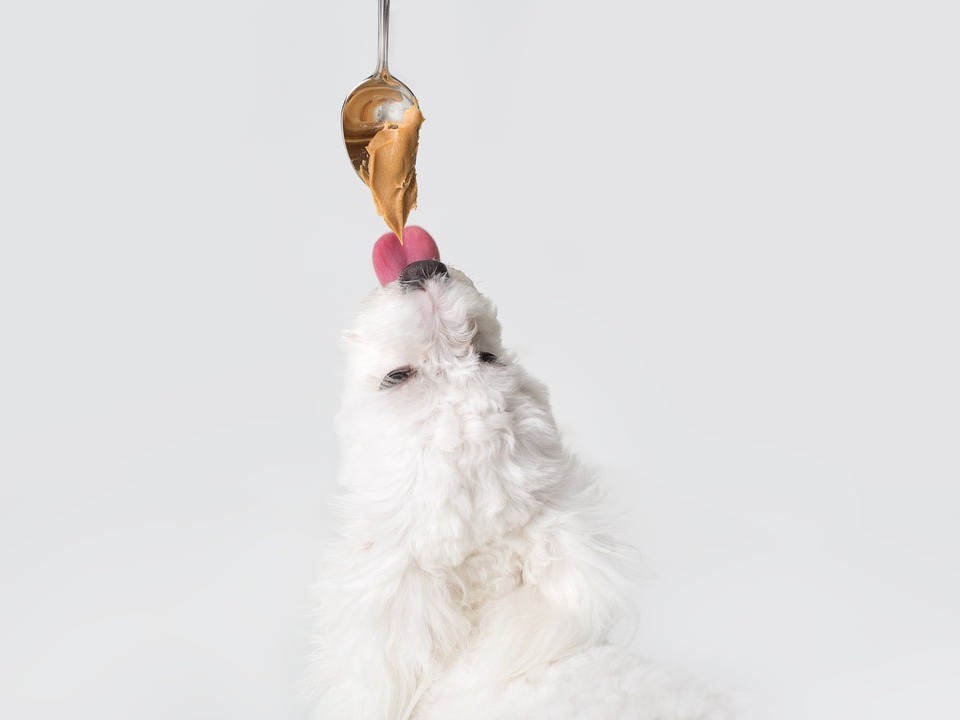
Xylitol Toxicity
Some peanut butter products, especially those branded “sugar–free” or “low sugar,” may contain xylitol, a sugar replacement that is very hazardous to dogs.
Even a tiny amount of xylitol can cause a quick and severe decline in blood sugar levels, potentially leading in seizures, liver failure, and even death.
Always read the ingredient list to confirm that the peanut butter does not contain xylitol[7].
A veterinary nutritionist, speaker and consultant for pet parents, pet supplements and the pet food industry Dr. Laura Gaylord says, “If you are going to use peanut butter to give your dog treats or medicine, which many people do, it should only have peanuts, salt and maybe sugar. Make sure it doesn’t have Xylitol.”
Digestive Upset
Introducing peanut butter too quickly or in large amounts can cause digestive upset in some dogs, leading to symptoms such as diarrhea, vomiting, or gas.
Choking Hazard
When using peanut butter as a treat or stuffing it into toys, ensure that it is spread thinly and does not create a choking hazard, especially for small dogs or those prone to gulping.
Nutritional Imbalance
While peanut butter contains beneficial nutrients, it should not replace a balanced and complete dog food diet. Excessive peanut butter consumption could lead to nutritional imbalances over time.
Salt and Additives
Some commercial peanut butters may contain added salt, sugar, or other additives that are not suitable for dogs.
Always choose natural peanut butter with minimal ingredients.
Pancreatitis
Greasy foods like shelled nut butter can trigger pancreatitis in a few pooches, particularly those with a history of the condition.
Pancreatitis is an irritation of the pancreas and can cause extreme stomach torment, heaving, and loose bowels
Training Treats
While peanut butter can be used as a training reward, it is vital to evaluate the entire treat and calorie consumption during training sessions.
Excessive sweets, such as peanut butter, can contribute to weight gain and other health problems.
Storage and Spoilage
Peanut butter can spoil over time, especially in warm and humid environments. Check the expiration date and store peanut butter properly to prevent spoilage.
Follow these tips to reduce these risks
- Choose natural peanut butter without added sugars, salts, or xylitol.
- Introduce peanut butter gradually and in moderation.
- Monitor your dog for any signs of allergies, digestive upset, or other adverse reactions.
- Consult your veterinarian before adding peanut butter to your dog’s diet, especially if your dog has any health concerns.
How to Give Your Dog Crunchy Peanut Butter
If you decide to give your dog crunchy peanut butter, here are some tips on how to do it safely and responsibly:
Check the label of the peanut butter and make sure it does not contain xylitol or other artificial sweeteners.
Measure the amount of peanut butter you give your dog and follow the 10 percent rule.
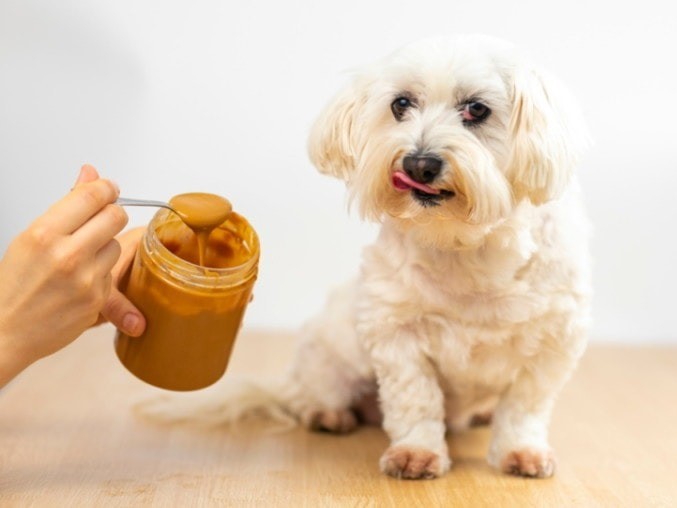
Use crunchy peanut butter as an occasional treat, not a regular part of your dog’s diet.
Spread crunchy peanut butter on a spoon or your finger and let your dog lick it off.
Stuff crunchy peanut butter inside a toy or bone and freeze it for a longer-lasting treat.
Mix crunchy peanut butter with other healthy ingredients such as oatmeal, banana, yogurt, or pumpkin and make homemade treats for your dog.
Since peanuts are not toxic to dogs, explains Dr. Laura Gaylord and the National Peanut Board (NPB), most peanut butter types, smooth or chunky, are safe for dogs to eat. You’ll want to make sure there are no other dangerous ingredients hiding in your favorite brand of sandwich spread, though, as artificial sweeteners like xylitol (AKA birch sugar, which is toxic to canines) can hide in the trickiest of places.
FAQs
Can dogs eat crunchy peanut butter?
Yes, dogs can eat crunchy peanut butter in moderation. The crunchy texture doesn’t pose any inherent danger, but be cautious about potential choking hazards, especially for dogs that tend to gulp down food.
Can I give my puppy crunchy peanut butter?
Puppies can enjoy peanut butter in moderation, including the crunchy variety. However, their digestive systems are still developing, so it’s best to consult your veterinarian before introducing any new foods to a puppy’s diet.
Is crunchy peanut butter safe for all dogs?
Crunchy peanut butter is generally safe for most dogs, but individual sensitivities can vary. Introduce peanut butter slowly and watch for any signs of allergies or adverse reaction
How much crunchy peanut butter can I give my dog?
Moderation is key. A small amount, such as a teaspoon or two, is generally sufficient. Peanut butter is calorie-dense, so it’s important not to overfeed to prevent weight gain.
Are there any alternatives to crunchy peanut butter for dogs?
If you’re worried about the crunchiness, incorporate a little quantity of smooth peanut butter with your dog’s usual meal.
Other dog-friendly fruits, such as apples or carrots, can give a crisp texture as well as extra nutrients.
Conclusion
In the great crunchy vs. creamy peanut butter debate for dogs, the winner ultimately depends on your furry friend’s preferences and dietary needs.
Both types can be a safe and enjoyable treat when fed in moderation and free from harmful additives like xylitol.
Remember, before introducing any new food into your dog’s diet, consult with your veterinarian, especially if your dog has any preexisting health conditions or dietary restrictions. So, feel free to spread a little crunchy joy.
Reference:
- Dog Health Symptoms A to Z | WebMD
- Pruritus – itching and scratching in dogs | VCA Animal Hospital
- Skin problems in dogs. (n.d.) | WebMD
- Edema in dogs | PetMD
- Gastroenteritis in dogs | VCA Animal Hospital
- How to get rid of stinky dog breath. American Kennel Club
- Xylitol toxicity in dogs | PubMed

Dania is a dog groomer living in California, who loves styling dogs. She often uses dog accessories to keep them distracted while grooming. She is also a dog parent to a Pomeranian, Duke. It’s because of him she is always on a lookout for the best dog foods, toys, other dog accessories, and ways to keep him equipped, healthy and happy.


